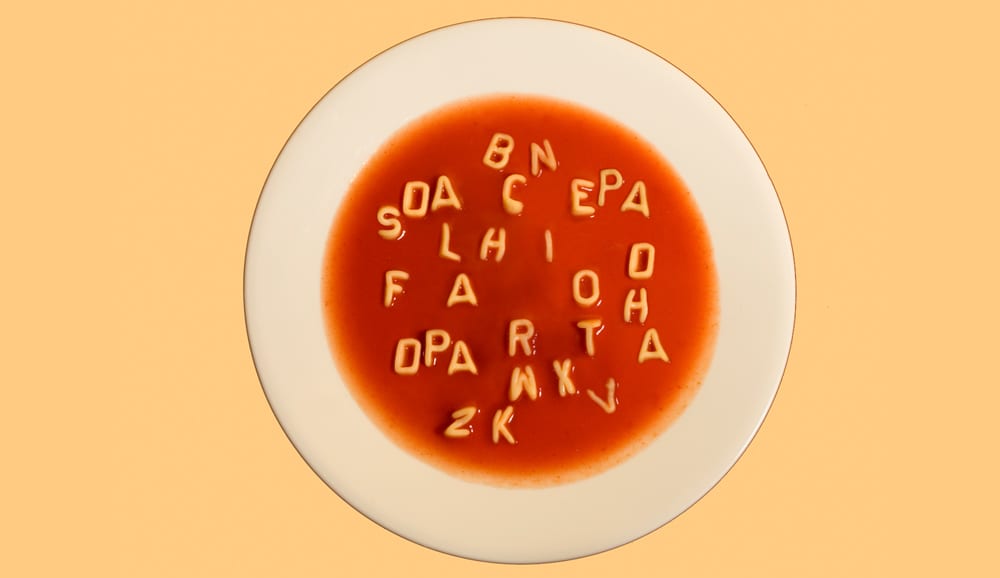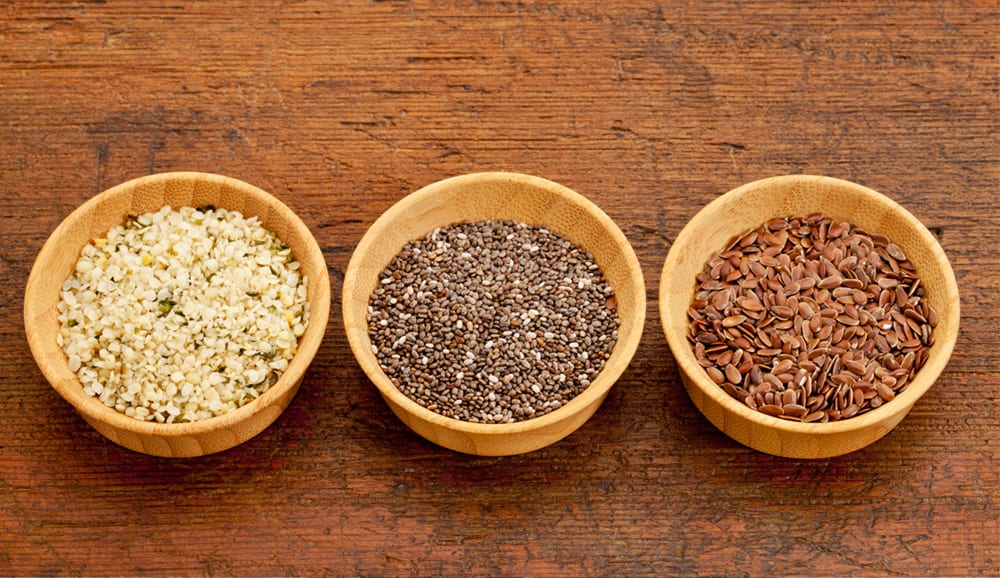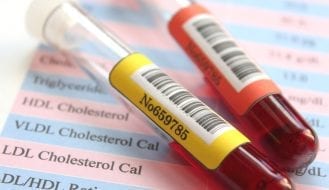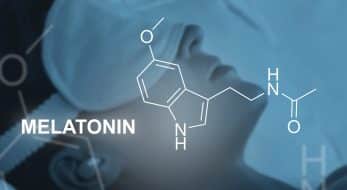EPA, DHA, ALA, DPA: How to Decipher the Omega-3 Alphabet Soup
It’s easy to get lost in the alphabet soup of the omega-3 fatty acid world. Acronyms like EPA, DHA, and DPA represent just a few of the members of the omega-3 family – and even that abbreviated list is enough to give consumers and health practitioners alike a headache.
But what do all these omega-3 abbreviations boil down to anyway? Let’s straighten out some key facts about these important fatty acids.
How Many Types of Omega-3s Are There?
In short: A lot. The term “omega-3” encompasses a broad range of fatty acids.
As a defining feature, all of these fatty acids share a double bond between the third and fourth carbon atoms from the methyl end.
A simplified model of an omega-3 molecule. All omega-3s have a double bond between the third and fourth carbon atom (hence the name ‘omega-3’).
MUFA vs PUFA
Omega-3s are typically divided into two main categories: monounsaturated fatty acids (MUFAs) and polyunsaturated fatty acids (PUFAs). MUFAs only have one double bond, while PUFAs have multiple double bonds. When people discuss omega-3s, they are usually just referring to the PUFA portion of the omega-3 family – even though the term omega-3s includes far more fatty acids than that (1).
In the PUFAs category alone, scientists have to date identified 33 different members (1), including the five most famous ones we’re covering below! In addition, there are some 10 different MUFAs and 20 unnamed very long-chain fatty acids with an undefined position of double bonds.
If you see the words “other omega-3s” on a fish oil supplement label, remember that any omega-3 (besides EPA and DHA) will typically get lumped under that heading.
EPA and DHA: The Most Popular Omega-3 Fatty Acids
Over the last 50 years, the omega-3 family has had two superstars: EPA and DHA. EPA stands for eicosapentaenoic acid (try to say that in one breath), and DHA is the acronym for docosahexaenoic acid (another tongue twister). Naturally found in fish and breast milk, EPA and DHA are considered the most potent omega-3s. That’s why the majority of the omega-3 research to date has fixated on these two fatty acids.
EPA and DHA first sparked the interest of young Danish researchers, Bang and Dyerberg, in the early 1970s (2). At that time, people believed that fat was the culprit behind the skyrocketing levels of cardiovascular disease in the Western world. Bang and Dyerberg analyzed the fat-rich diet of Inuits in Greenland, where heart disease was almost nonexistent. Since the Inuits’ diet largely consisted of fish and seal – two rich sources of EPA and DHA – Bang and Dyerberg speculated that higher intakes of EPA and DHA might reduce the risk of coronary heart disease.
The rest is history. Since the two researchers published their first papers, EPA and DHA have become the focus of tens of thousands of studies. Today, these omega-3s are some of the most rigorously researched nutrients of all time, with scientists discussing their applications for not just the heart, but virtually every other aspect of health as well.
Omega-3 researchers, Bang and Dyerberg, got their start in Greenland, analyzing the omega-3-rich diet of the Inuits.
How Do EPA and DHA Work?
EPA and DHA are often referred to as “very long-chain fatty acids.” That’s a fancy way of saying that EPA and DHA contain more carbon atoms and double bonds than other types of omega-3s. This chemical structure makes them highly flexible, allowing them to quickly change their shape and connect with other important molecules.
Both EPA and DHA are critical for the healthy functioning of every cell in the body. They help create a fluid cell membrane structure and also influence cell signaling and gene expression. EPA and DHA are also the precursors for a host of inflammation-resolving molecules known as specialized pro-resolving mediators (SPMs), which we’ll discuss in greater detail below.
Because of their profound influence at the cellular level, EPA and DHA are instrumental for the healthy growth, development, and maintenance of every cell and tissue in our body (3).
Housed in the cell membrane of every cell, EPA and DHA influence cell signaling, among other important roles.
The Difference Between EPA and DHA
EPA and DHA are often written about as a pair, but over the last decade, we’ve also started to learn more about their individual differences.
DHA, for instance, seems to be especially important for the healthy development of the eye and brain. Comprising some 50-70% of the fatty acids in the rod outer segments of the retina, DHA has been shown as essential for optimal visual functioning (3). DHA also makes up a large percentage of the fatty acids in the brain, and is important for healthy neurotransmission, neuronal membrane stability, and neuroplasticity (3).
That’s not to say that EPA isn’t important in these areas, too. For instance, a number of studies on mental health issues (including depression and psychiatric disorders) have indicated that EPA may be more beneficial than DHA for managing symptoms (3, 4).
We’re still in the early stages of understanding exactly how these powerhouses work. For instance, a 2020 Tufts University study discovered that DHA had a more powerful anti-inflammatory effect compared to EPA, but EPA was better at improving the balance between pro and anti-inflammatory proteins (5).
ALA: The Omega-3 Family’s Most ‘Immature’ Member
In the omega-3 family, ALA (alpha linolenic acid) may seem like it has gotten the short stick when it comes to omega-3 research. That’s likely because – compared to its long-chained EPA and DHA siblings – ALA is shorter, with fewer carbon atoms and double bonds. As such, ALA does not have the same reactivity as EPA and DHA, and therefore has a different physiological role.
The Relationship Between ALA, EPA, & DHA
For a long time, the benefits of ALA were largely understood in terms of its ability to convert into EPA and DHA in the body. Because various plant sources (e.g. flaxseed, walnuts, chia seeds) contain ALA, many institutions promoted plant-based foods as good sources of omega-3s. People thought that as long as they ate enough plant-based ALA, they’d be fine in the omega-3 department.
As further research has demonstrated, however, the conversion of ALA into EPA and DHA is minimal at best. Depending on factors like genetics, sex, and diet, only about 5% of ALA gets converted to EPA. For ALA into DHA, the conversion rate is a dismal 0.5% (6).
Chia, flax, and hemp seeds do contain omega-3 fatty acids – but only of the ALA variety (not EPA or DHA).
The Benefits of ALA
While banking on ALA to fulfill one’s need for EPA and DHA doesn’t cut it for most people, research suggests that ALA may have benefits of its own. For instance, high intakes of ALA-based foods are associated with better cardiovascular health. In cell studies, ALA has also been shown to lower levels of inflammation-related biomarkers (like interleukin-6) (6).
Still, we have a lot to learn about ALA. In fact, out of the ever-growing 30,000+ studies on omega-3s, the vast majority have concentrated on EPA and DHA, not ALA.
DPA: Another Important Member of the Omega-3 Family
Docosapentaenoic acid (DPA) is a lesser known omega-3 family member, but it’s gaining more traction as researchers start to uncover its benefits.
Like EPA and DHA, DPA is also classified as a “very long-chain fatty acid” and is predominantly found in fatty fish, seal meat, and breast milk (7). It also has the same number of carbon atoms as DHA and the same number of double bonds as EPA.
How Does DPA Work?
Because of its structural similarities and overlapping functions, DPA is often seen as a sort of middleman between EPA and DHA. Indeed, DPA can both retro-convert into EPA and further elongate into DHA. This has led some scientists to suggest that one of DPA’s roles may be to act as a reservoir for EPA and DHA, depending on what the body needs the most (7).
Like EPA and DHA, DPA is important for improving lipid metabolism, decreasing aortic plaque build-up, and reducing chronic inflammation. But DPA likely has unique functions, too. For one, DPA is the precursor for its own families of inflammation-fighting SPMs. Studies also suggest that DPA may inhibit platelet aggregation more efficiently than EPA or DHA, potentially making it better at reducing the formation of blood clots (7).
SDA: Omega-3 with Plant-Based Potential
One other notable omega-3 member that has gotten some research attention is SDA (stearidonic acid). SDA can be found in some fish and plant sources (e.g. hemp, echium seed, sea-buckthorn, and blackcurrant seed) (1, 8). Some Big Pharma and seed monoliths, like Monsanto, have also created genetically-modified soybeans that are rich in SDA.
Similar in length and structure to ALA, SDA has mostly been valued for its ability to convert into EPA and DHA in the body. On that note, research shows that SDA converts more efficiently into EPA than ALA (9). Indeed, one meta-analysis found that individuals who consumed SDA had twice as much EPA in their red blood cells as those who received ALA (8).
While SDA doesn’t convert into DHA very well, eating more SDA-rich foods and oils might be beneficial.
Fish, as well as some plant sources (like the sea buckthorn pictured here) contain small amounts of the fatty acid SDA.
SPMs: Omega-3 Derived Molecules of the Future
For decades, scientists have studied omega-3 fatty acids’ powerful anti-inflammatory benefits. But exactly how these fatty acids put out the inflammation fires was not entirely understood until new research emerged in the mid-2000s. That’s when researchers discovered that EPA, DHA, and DPA are substrates for new families of potent molecules called SPMs (short for specialized pro-resolving mediators).
These groups of molecules (including resolvins, protectins, and maresins) do exactly what their names imply: They resolve and protect against inflammation. They are also involved in reducing pain, protecting against bacterial infection, and important for tissue regeneration, among other functions (10, 11).
Importantly, EPA, DHA and DPA are all precursors for different families of SPMs (10), and each of these families support our body’s immune response in unique ways. For instance, EPA is the “parent” for Resolvin E1, which helps clear the tissue of inflammation-driving neutrophils and reduces platelet aggregation. DHA is the substrate for Protectin D1, which blocks T cell migration and reduces cytokine production (12). All of these specific actions are important for protecting our tissues and organs from damage after an inflammatory response to an injury or infection.
SPMs are now one of the hottest topics in omega-3 research, with special focus on cancers, cardiovascular diseases, autoimmune disorders, and much more. Fortunately, it appears that the doses needed for benefits are extremely small – down to nanograms and picograms (11, 12).
You can see a full list of the various omega-3-derived SPM families discovered to date here, as well as a more comprehensive overview of their many varied functions here.
The omega-3 family can be thought of much like an orchestra. Each member plays an important role in creating a beautiful symphony!
Full-Spectrum Omega-3 Is Vital
With so many acronyms, it can be easy to lose sight of the main point: Omega-3 represents a family of many members, and all the different members work in synchronicity to support optimal cellular function. Unfortunately, an increasing number of supplement and pharmaceutical companies manufacture concentrates of these fatty acids. Today, there are EPA-only products, DHA-only products, DPA-concentrates, and SPM-specific supplements.
While fatty acid-specific products are certainly helpful for scientists examining their unique physiological effects, this tunnel-vision approach is too narrow for good health outcomes. Firstly, the more processed and concentrated these fatty acids are, the more they risk losing their stability and nutritional integrity (13).
Furthermore, the various members of the omega-3 family have clear synergistic effects. Limiting EPA as “the only important fatty acid for mental health” or DHA as “the only important fatty acid for infant development” is short-sighted given the complexity of the human body and our ever-developing understanding of how these nutrients work.
Choose Full-Spectrum Omega Cure Products
The omega-3 family is certainly complex, diverse, and full of surprises (scientists keep finding new members)! But discovering them all – and how they each contribute to helping the body reach its full potential – is part of the joy of working in this field.
At Omega3 Innovations, our medical background and research has always emphasized full-spectrum omega-3 fish oil. And as such, the Omega Cure® used in all of our products not only provides EPA and DHA, but also the other important members of the omega-3 family – and their nutrient cofactors, too.
An Effective Omega-3 Dose, Made Simple
Experience the Omega3 Innovations difference for yourself with the most effective fish oil supplement on the market.
Buy Now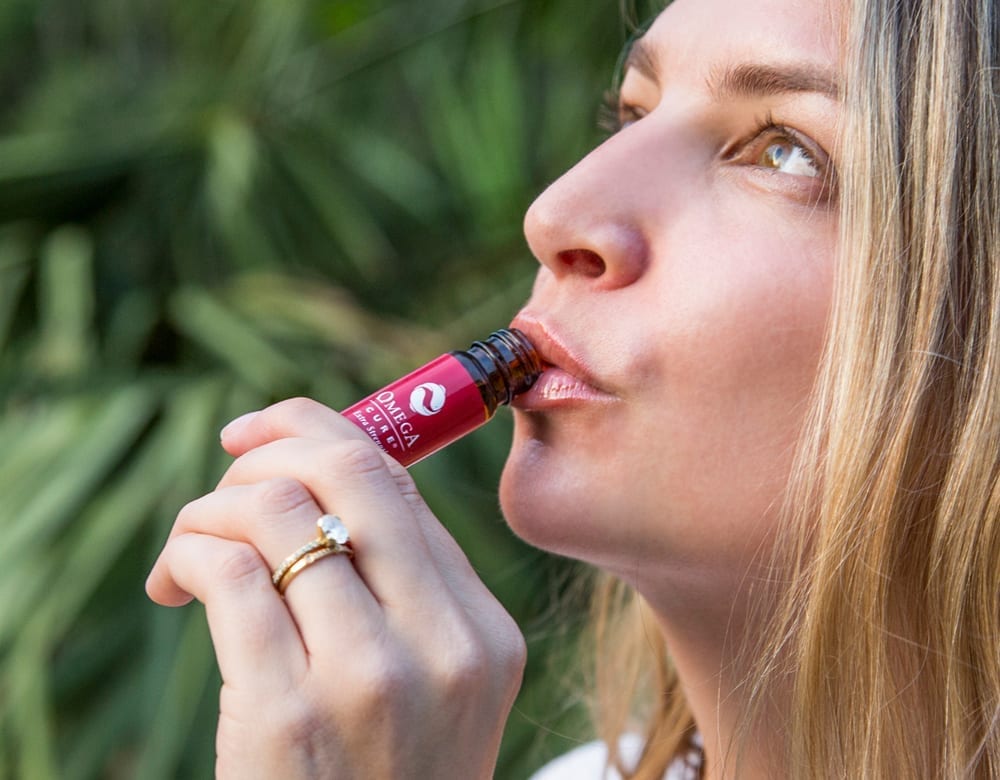
References:
1. Cholewski, M., Tomczykowa, M., & Tomczyk, M. (2018). A Comprehensive Review of Chemistry, Sources and Bioavailability of Omega-3 Fatty Acids. Nutrients, 10(11), 1662.
2. Daniells, Stephens. (2016, March 31). The Omega-3 Pioneer. NutraIngredients-USA.
3. Calder, P. (2018). Very Long-Chain N-3 Fatty Acids and Human Health: Fact, fiction and the Future. Proceedings of the Nutrition Society, 77(1), 52-72.
4. Dyall S. C. (2015). Long-Chain Omega-3 Fatty Acids and the Brain: A Review of the Independent and Shared Effects of EPA, DPA and DHA. Frontiers in Aging Neuroscience, 7, 52.
5. Tufts University, Health Sciences Campus. (2020, December 7). Fish Oil Omega-3s EPA and DHA Work Differently on Chronic Inflammation: Small Randomized Trial in Older Adults Compares Benefits of the Two in Supplements. ScienceDaily.
6. Santos, H. O., Price, J. C., & Bueno, A. A. (2020). Beyond Fish Oil Supplementation: The Effects of Alternative Plant Sources of Omega-3 Polyunsaturated Fatty Acids upon Lipid Indexes and Cardiometabolic Biomarkers-An Overview. Nutrients, 12(10), 3159.
7. Byelashov, O. A., Sinclair, A. J., & Kaur, G. (2015). Dietary Sources, Current Intakes, and Nutritional Role of Omega-3 Docosapentaenoic Acid. Lipid Technology, 27(4), 79–82.
8. Sherry, A. (2014, July). Spotlight on Stearidonic Acid — Learn More About This Alternative Omega-3 Fatty Acid. Today’s Dietitian, 16(7), 18.
9. Greupner, T., Koch, E., Kutzner, L., Hahn, A., Schebb, N. H., & Schuchardt, J. P. (2019). Single-Dose SDA-Rich Echium Oil Increases Plasma EPA, DPAn3, and DHA Concentrations. Nutrients, 11(10), 2346.
10. Hansen, T. V., Dalli, J., & Serhan, C. N. (2017). The Novel Lipid Mediator PD1n-3 DPA: An Overview of the Structural Elucidation, Synthesis, Biosynthesis and Bioactions. Prostaglandins & Other Lipid Mediators, 133, 103–110.
11. Serhan, C. N., Dalli, J., Colas, R. A., Winkler, J. W., & Chiang, N. (2015). Protectins and Maresins: New Pro-Resolving Families of Mediators in Acute Inflammation and Resolution Bioactive Metabolome. Biochimica et Biophysica Acta, 1851(4), 397–413.
12. Duvall, M. G., & Levy, B. D. (2016). DHA- and EPA-Derived Resolvins, Protectins, and Maresins in Airway Inflammation. European Journal of Pharmacology, 785, 144–155.
13. Dasilva, G., Boller, M., Medina, I., & Storch, J. (2018). Relative Levels of Dietary EPA and DHA Impact Gastric Oxidation and Essential Fatty Acid Uptake. The Journal of Nutritional Biochemistry, 55, 68–75.
Recent Posts
-
Dose, Joint Health, Omega-3
Omega-3 & Pain Relief: Finding the Best Strategy
Are you one among the 1 in 5 Americans grappling with chronic pain, as reported by the CDC [1]? If the thought of traditional pain medications and their potential side...3 months ago -
Eye Health, Omega-3
The Startling Link Between Skin Care and Eye Health
Dry eye complaints are on the rise worldwide. Many risk factors – including aging and increased computer use – help explain the increase. But there's another driver few people know...5 months ago -
Heart Health
Does Taking Fish Oil Lower Cholesterol?
Many people believe that incorporating omega-3s into their diet will solve their cholesterol woes. But the truth is much more nuanced; it's not as simple as taking a daily fish...1 year ago -
Immune Health, Sleep
Melatonin & COVID-19: Can This ‘Sleep Hormone’ Help?
It started with a runny nose and a slight cough. But when his 72-year-old wife tested positive for COVID-19, he got concerned. “Is there any research suggesting the supplements we...2 years ago -
Full-Spectrum Fish Oil, Omega-3
Is It Good to Store Fish Oil in the Freezer?
Fish oil is a great source of the omega-3 fatty acids we all need for good health. It’s also highly perishable. Consuming rancid fish oil can have negative health implications....2 years ago -
Omega-3
Our Favorite Omega-3 Fish Oil Benefits
Omega-3 fish oil certainly has a reputation for delivering a plethora of incredible benefits. And it’s true! Omega-3 fatty acids have been studied for a broad range of health conditions....2 years ago


